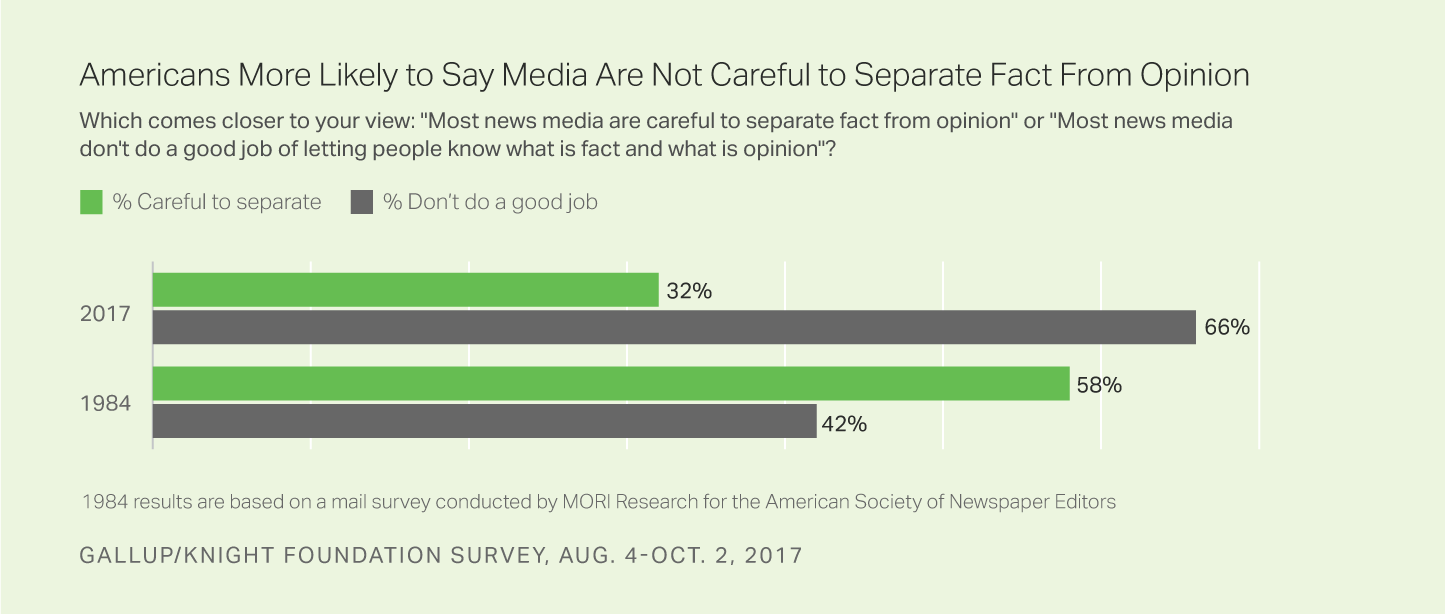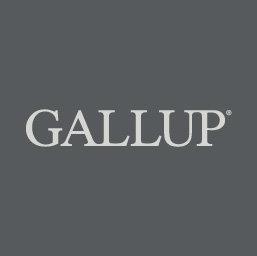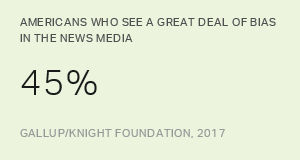Story Highlights
- 32% say media careful to separate fact from opinion; was 58% in 1984
- 45% see great deal of political bias in news coverage, up from 25% in 1989
- Majority cannot name a source that reports news objectively
WASHINGTON, D.C. -- Americans' perceptions of news media bias have increased significantly over the past generation. Thirty-two percent believe the news media are careful to separate fact from opinion, well below the 58% who held this view in 1984. Meanwhile, 66% currently agree that most news media do not do a good job of letting people know what is fact and what is opinion, up from 42%.

These results are based on a new Gallup/Knight Foundation survey on trust, media and democracy. The large-scale mail survey of more than 19,000 U.S. adults was conducted Aug. 4-Oct. 2, 2017. The historical comparisons are based on a 1984 mail survey conducted by MORI Research for the American Society of Newspaper Editors.
Additionally, the new Gallup/Knight survey finds nearly half of Americans, 45%, saying there is "a great deal" of political bias in news coverage. This represents a sharp increase compared with what other polls have measured on the same question in the past, including 25% in a 1989 Pew Research Center telephone survey and 37% in that firm's most recent update, in 2012.
Perceptions of media bias are strongly related to one's political leanings.
- Fifty-three percent of Democrats, but only 27% of independents and 13% of Republicans, believe the media are careful to separate fact from opinion.
- Twenty-six percent of Democrats versus 67% of Republicans perceive a great deal of political bias in news coverage. Independents fall more squarely between Republicans and Democrats on this measure, with 46% saying news coverage has a great deal of political bias.
Majorities of Americans consider each of seven possible types of bias evaluated in the survey to be problematic in news coverage today. A high of 69% say that news outlet owners attempting to influence the way stories are reported is a major problem, while a low of 57% say news organizations reporting information they believed to be accurate but that turned out to be inaccurate is a major problem.
| Major problem | Minor problem | Not a problem | |||||||||||||||||||||||||||||||||||||||||||||||||||||||||||||||||||||||||||||||||||||||||||||||||
|---|---|---|---|---|---|---|---|---|---|---|---|---|---|---|---|---|---|---|---|---|---|---|---|---|---|---|---|---|---|---|---|---|---|---|---|---|---|---|---|---|---|---|---|---|---|---|---|---|---|---|---|---|---|---|---|---|---|---|---|---|---|---|---|---|---|---|---|---|---|---|---|---|---|---|---|---|---|---|---|---|---|---|---|---|---|---|---|---|---|---|---|---|---|---|---|---|---|---|---|
| % | % | % | |||||||||||||||||||||||||||||||||||||||||||||||||||||||||||||||||||||||||||||||||||||||||||||||||
| Owners of news outlets attempting to influence the way stories are reported | 69 | 24 | 4 | ||||||||||||||||||||||||||||||||||||||||||||||||||||||||||||||||||||||||||||||||||||||||||||||||
| News organizations being too dramatic or too sensational in order to attract more readers or viewers | 66 | 27 | 5 | ||||||||||||||||||||||||||||||||||||||||||||||||||||||||||||||||||||||||||||||||||||||||||||||||
| Too much bias in the reporting of news stories that are supposed to be objective | 65 | 29 | 4 | ||||||||||||||||||||||||||||||||||||||||||||||||||||||||||||||||||||||||||||||||||||||||||||||||
| Too much bias in the selection of what stories news organizations cover or don't cover | 64 | 29 | 4 | ||||||||||||||||||||||||||||||||||||||||||||||||||||||||||||||||||||||||||||||||||||||||||||||||
| More news sources reporting from a particular point of view rather than being neutral | 61 | 31 | 6 | ||||||||||||||||||||||||||||||||||||||||||||||||||||||||||||||||||||||||||||||||||||||||||||||||
| Not enough investigative journalism to uncover important facts | 59 | 30 | 8 | ||||||||||||||||||||||||||||||||||||||||||||||||||||||||||||||||||||||||||||||||||||||||||||||||
| News organizations reporting information they think is accurate but turns out to be inaccurate | 57 | 35 | 6 | ||||||||||||||||||||||||||||||||||||||||||||||||||||||||||||||||||||||||||||||||||||||||||||||||
| Aug. 4-Oct. 2, 2017 | |||||||||||||||||||||||||||||||||||||||||||||||||||||||||||||||||||||||||||||||||||||||||||||||||||
| Gallup/Knight Foundation Survey on Trust, Media and Democracy | |||||||||||||||||||||||||||||||||||||||||||||||||||||||||||||||||||||||||||||||||||||||||||||||||||
The concerns Americans express about these various forms of bias rival those they have about the spread of inaccurate information on the internet. A separate item found 73% of Americans saying the spread of false information over the web is a major problem today.
Majority in U.S. Cannot Name an Objective News Source
With perceptions of bias so pervasive, it is perhaps not surprising that less than a majority of Americans, 44%, say they can think of a news source that reports the news objectively. Even though Democrats are much less likely to perceive bias in the media than Republicans, Democrats are only somewhat more likely than Republicans to say they can think of an objective news source, 51% to 42%.
Americans who describe their ideological views as "very liberal," "liberal" or "very conservative"; have a postgraduate education; or are aged 65 and older are most likely to say they can identify an objective news source. Younger, less educated and moderate respondents are among the major subgroups least likely to say this.
| Yes, can | No, cannot | |||||||||||||||||||||||||||||||||||||||||||||||||||||||||||||||||||||||||||||||||||||||||||||||||||
|---|---|---|---|---|---|---|---|---|---|---|---|---|---|---|---|---|---|---|---|---|---|---|---|---|---|---|---|---|---|---|---|---|---|---|---|---|---|---|---|---|---|---|---|---|---|---|---|---|---|---|---|---|---|---|---|---|---|---|---|---|---|---|---|---|---|---|---|---|---|---|---|---|---|---|---|---|---|---|---|---|---|---|---|---|---|---|---|---|---|---|---|---|---|---|---|---|---|---|---|---|
| % | % | |||||||||||||||||||||||||||||||||||||||||||||||||||||||||||||||||||||||||||||||||||||||||||||||||||
| U.S. adults | 44 | 51 | ||||||||||||||||||||||||||||||||||||||||||||||||||||||||||||||||||||||||||||||||||||||||||||||||||
| Party identification | ||||||||||||||||||||||||||||||||||||||||||||||||||||||||||||||||||||||||||||||||||||||||||||||||||||
| Democrat | 51 | 44 | ||||||||||||||||||||||||||||||||||||||||||||||||||||||||||||||||||||||||||||||||||||||||||||||||||
| Independent | 40 | 56 | ||||||||||||||||||||||||||||||||||||||||||||||||||||||||||||||||||||||||||||||||||||||||||||||||||
| Republican | 42 | 54 | ||||||||||||||||||||||||||||||||||||||||||||||||||||||||||||||||||||||||||||||||||||||||||||||||||
| Age | ||||||||||||||||||||||||||||||||||||||||||||||||||||||||||||||||||||||||||||||||||||||||||||||||||||
| 18 to 29 years old | 35 | 62 | ||||||||||||||||||||||||||||||||||||||||||||||||||||||||||||||||||||||||||||||||||||||||||||||||||
| 30 to 49 years old | 40 | 56 | ||||||||||||||||||||||||||||||||||||||||||||||||||||||||||||||||||||||||||||||||||||||||||||||||||
| 50 to 64 years old | 48 | 48 | ||||||||||||||||||||||||||||||||||||||||||||||||||||||||||||||||||||||||||||||||||||||||||||||||||
| 65+ years old | 52 | 41 | ||||||||||||||||||||||||||||||||||||||||||||||||||||||||||||||||||||||||||||||||||||||||||||||||||
| Education | ||||||||||||||||||||||||||||||||||||||||||||||||||||||||||||||||||||||||||||||||||||||||||||||||||||
| Postgraduate | 59 | 38 | ||||||||||||||||||||||||||||||||||||||||||||||||||||||||||||||||||||||||||||||||||||||||||||||||||
| Four-year college degree only | 50 | 47 | ||||||||||||||||||||||||||||||||||||||||||||||||||||||||||||||||||||||||||||||||||||||||||||||||||
| Some college | 43 | 53 | ||||||||||||||||||||||||||||||||||||||||||||||||||||||||||||||||||||||||||||||||||||||||||||||||||
| High school or less | 35 | 58 | ||||||||||||||||||||||||||||||||||||||||||||||||||||||||||||||||||||||||||||||||||||||||||||||||||
| Ideology | ||||||||||||||||||||||||||||||||||||||||||||||||||||||||||||||||||||||||||||||||||||||||||||||||||||
| Very liberal | 67 | 29 | ||||||||||||||||||||||||||||||||||||||||||||||||||||||||||||||||||||||||||||||||||||||||||||||||||
| Liberal | 56 | 41 | ||||||||||||||||||||||||||||||||||||||||||||||||||||||||||||||||||||||||||||||||||||||||||||||||||
| Moderate | 38 | 57 | ||||||||||||||||||||||||||||||||||||||||||||||||||||||||||||||||||||||||||||||||||||||||||||||||||
| Conservative | 41 | 55 | ||||||||||||||||||||||||||||||||||||||||||||||||||||||||||||||||||||||||||||||||||||||||||||||||||
| Very conservative | 52 | 42 | ||||||||||||||||||||||||||||||||||||||||||||||||||||||||||||||||||||||||||||||||||||||||||||||||||
| Aug. 4-Oct. 2, 2017 | ||||||||||||||||||||||||||||||||||||||||||||||||||||||||||||||||||||||||||||||||||||||||||||||||||||
| Gallup/Knight Foundation Survey on Trust, Media and Democracy | ||||||||||||||||||||||||||||||||||||||||||||||||||||||||||||||||||||||||||||||||||||||||||||||||||||
The survey asked those who could name an objective source to identify which specific outlets they believe report news objectively. Among Republicans, Fox News was the overwhelming winner, with 60% of Republicans who named an objective news source identifying Fox News as that source.
There is far less agreement among Democrats about which news source is objective. Rather than coalescing around a single news organization, Democrats name a number of sources, led by CNN (21%) and NPR (15%).
Among age groups, Americans aged 50 and older who named an objective news source identify Fox News by a significant margin over other news outlets. Those younger than 50 are about as likely to name CNN, NPR or Fox News as organizations that report the news objectively.
Among educational groups, postgraduates who could mention a news source most commonly mentioned NPR, at 19%, followed by CNN and Fox News at 13% each. NPR also ranks first among very liberal respondents, at 26%, with only 1% naming Fox News. By contrast, solid majorities of very conservative (58%) and conservative (55%) respondents who could think of an objective source mentioned Fox News.


